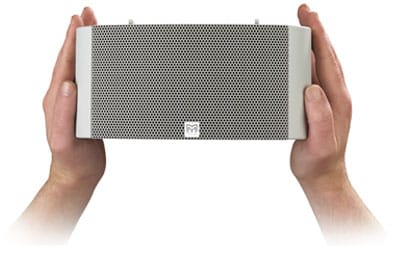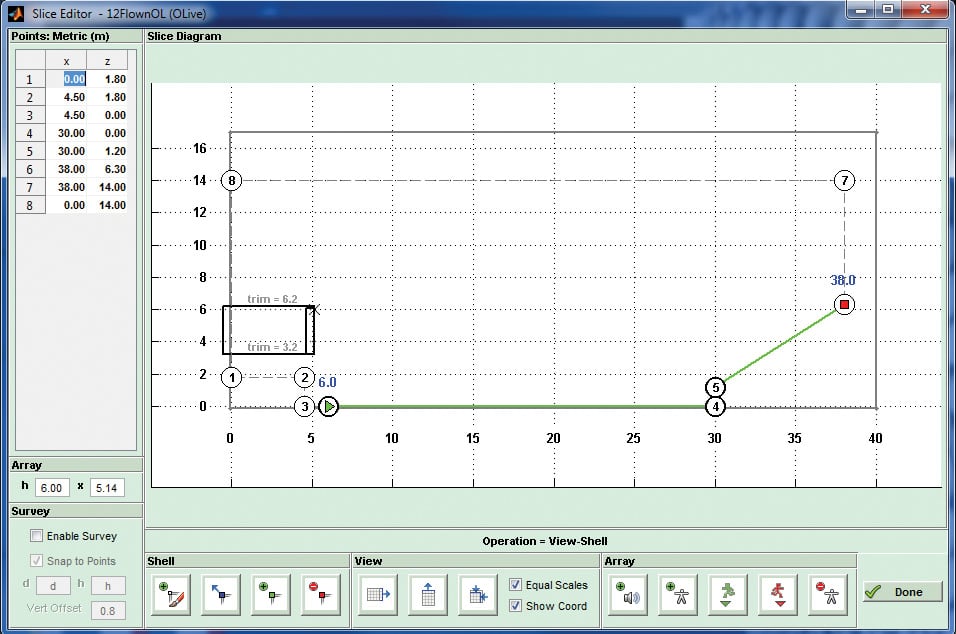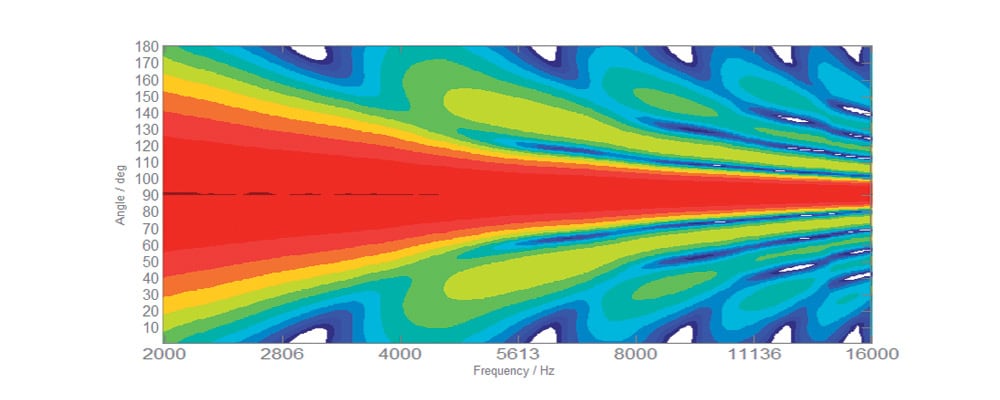
The array configuration for a specific area is determined by industry leading optimisation software which makes intelligent judgements about how well the array performs against objective target functions. This enables focused sound energy to be delivered precisely where needed and kept away from reflective surfaces and ceilings — reducing the detrimental influence of the room and increasing clarity and intelligibility in challenging acoustic environments.

Step 1: Venue entry

Step 2: Set coverage parameters

Step 3: Calculate splay angles

Step 4: Optimisation and upload
This can now be taken further with DSP optimisation delivered via DISPLAY and the use of either iK81 amplifier or a VIA2004 amplifier with a DX4.0 controller, to independently control and power each individual enclosure, or groups of enclosures.
This unlocks the full potential of O-Line — further refining coverage consistency and increasing the ability to ‘dial-out’ the influence of the room by accessing DISPLAY’s ‘hard avoid’ capability and electronically adjustable coverage
This can also enable additional benefits to any installation. More often than not, many installations can suffer from height restrictions and the combination of both mechanical and DSP optimisation can compensate this challenge. Similarly, some installations require a flatter array for aesthetic reasons and so additional DSP optimisation can compensate for the lack of mechanical optimisation available. There is also the scenario that following an installation something changes in the venue and rather than have to de-rig and re-rig, electronic optimisation alone can provide a level of coverage change. Similarly, it maybe that the venue is multi-purpose with changing sizes of audience and so by using DISPLAY with VU-NET control it’s possible to have different pre-sets to cater for these coverage changes.
Amplification and control can be done either by using an IK81 or the combination of VIA2004 amplifier and a DX4.0 controller.
The iK81 is an advanced eight-channel amplifier which combines very high power density with superb audio performance. It features onboard IIR and FIR filtering to control the amplitude, phase and EQ of each O-Line module individually, with the filter parameters calculated and uploaded by DISPLAY. The iK81 employs comprehensive protection functions to maintain safe operating conditions of both the amplifier and the O-Line.
The VIA2004 is an advanced 4-channel power amplifier which delivers superb audio performance in a lightweight, cost-effective package. DX4.0 is an advanced loudspeaker controller and system matrix with four input and eight output channels. Class-leading sonic performance is achieved by state-of-the-art audio converters and DSP algorithms, with a 96kHz sampling frequency delivering a nominally flat response beyond 40kHz. It features FIR filtering to support O-Line optimisation.
The level of coverage, consistency and control is further refined by the level of resolution of the array in terms of the number of enclosures to amp channels.
The higher the resolution, so too the improvement in coverage and consistency of frequency response and SPLs throughout the venue within a tight window specified by the user.
In the ultimate one enclosure to one amplifier channel mode [One Box Resolution] it is possible to simultaneously optimise the direct field where sound is required, keep the sound away from reflective surfaces and minimise reverberant sound power to an extent not previously possible from a commercially available system of such high sound quality, small size and aesthetic appeal.
Ethernet is used for system remote control and monitoring via Martin Audio’s VU-NET software application, while a user-friendly front panel interface allows full local control of all features. Dante digital audio network inputs are also provided for digital audio distribution and control.

O-Line -16 box hang – 8 box resolution

O-Line -16 box hang – 1 box resolution.
The higher the resolution, so too the improvement in coverage and consistency of frequency response and SPLs throughout the venue within a tight window specified by the user.
In the ultimate one enclosure to one amplifier channel mode [One Box Resolution] it is possible to simultaneously optimise the direct field where sound is required, keep the sound away from reflective surfaces and minimise reverberant sound power to an extent not previously possible from a commercially available system of such high sound quality, small size and aesthetic appeal.
Ethernet is used for system remote control and monitoring via Martin Audio’s VU-NET software application, while a user-friendly front panel interface allows full local control of all features. Dante digital audio network inputs are also provided for digital audio distribution and control.
Up to 24 modules can be connected where both high output and vertical focussing down to low/mid frequencies are required. Smaller numbers of modules (down to 4) can be used for shorter-throw applications, where vertical focussing of the low/ mid frequencies is less important. This scalability means that O-Line can be used in an extremely wide variety of applications – from bars and restaurants to sports venues, churches and railway concourses.

A passive two-way system, each module consists of 2 x 3 ½” (87mm) low/mid radiators either side of a central strip of 5 x 0.55” (14mm) miniature HF devices on a 100° horizontal waveguide. The horizontal constant-directivity characteristics are maintained down through the midband by the very close physical spacing of the low/mid drivers, whose sculpted, stiff and ultra-light cones follow the contours of the waveguide walls – avoiding wall-cavity effects and contributing to the flawless 100° horizontal constant-directivity pattern.
An internal 2.5kHz passive crossover in each module divides the audio input between the LF and HF sections.

O-Line uses a line of five custom-designed HF dome tweeters, with a spacing of only 0.83” (21mm) between each device. Such small spacing relegates high frequency vertical sidelobes to outside the audio band.

Compare this to using off-the-shelf 1” (25mm) dome tweeters. Sidelobes as loud as the main (red) lobe appear at frequencies as low as 8kHz; well within the audio band!
O-Line is capable of surprisingly high output for its size, even though it uses small, direct radiators rather than compression drivers to produce high frequencies. High output is possible because there are five HF devices in each module – resulting in an effective HF voice coil diameter of 3 inches (75mm) with a corresponding increase in power handling. This is important, since it is the HF section in a line array that has the most demanded of it, due to increased air absorption at high frequencies.
Inter-cabinet angles of 0° to 5° are set in 1° steps via rear-mounted link plates and link pins. Rear covers maintain the sleek, unobtrusive appearance required of an architectural loudspeaker product.
Arrays can be wall mounted or flown via optional brackets. They are designed to be unobtrusive and adaptable in order to blend in with their environment. Up to 16 cabinets can be wall mounted using the optional brackets. Pan and tilt are easily achievable. Arrays can be panned left or right and then the bracket locked in position. Tilt is achieved by setting the length of a wire rope or chain ‘pull-back’ strap, allowing accurate on-site adjustment of array aiming. The brackets are designed as 1st/2nd fix components in accordance with typical installation methods.

Speak to one of our Consultants now
Do you have an upcoming event or project and need assistance on product selection? Or do you need expert advice? Drop us a note, we are ready to help.